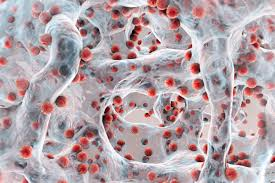Award Winning Author
Face Reading with Before & After Photos
How to Maintain Healthy Gut Flora

For proactive healthcare, a basic understanding of biofilms is a requisite. The term biofilm refers to organic life forms (bacteria, yeasts and other microorganisms) that develop an extracellular matrix or, to be more graphic, a slimy film. Biofilms are a living, self-protective community that can develop and stick to any surface—living or otherwise—that is exposed to water.
When the Good Becomes Bad
Our personal biofilms include dental plaque, which films over our teeth, and gut flora, which coats our intestinal lining. We can cultivate external biofilms such as with a kombucha starter (SCOBY). However, if you have a medical implant such as a joint replacement or catheter, then you don’t want a bacteria-laden film glomming onto it, as this would cause inflammation. Biofilms are implicated with cancer, candida, cardiovascular disease, chronic fatigue, chronic infection, cystic fibrosis, dementia, Legionnaires’ disease, Lyme disease, and more.
Intestinal biofilms are an integral component of a healthy gut. However, if the gut is challenged, then what was a part of your healthy defense system can overgrow and become stubbornly problematic. As biofilms are self-protective, they morph to resist antibiotics, making related infections both recurrent and chronic.
Challenge the Nasties
One way to remove unwanted biofilms such as dental plaque or a sludge-blocked drain in your kitchen sink is with physical measures. A dental technician can scrape off the plaque, or a plumber can ream out the slime.
The second option for biofilm removal is to apply an agent that penetrates into and disperses the film. Aspartame, for example, breaks up dental plaque and so chewing gum with aspartame apparently helps control it. (Given its dangerous side effects, I don’t, however, recommend this artificial sweetener.) For drainpipe problems, you can use caustic chemicals or, more naturally, enzymes that penetrate, disrupt and then disperse the extra cellular matrix.
But cleaning out the biofilm doesn’t end the story. As long as you have water and germs in your mouth and sink, new biofilms will form. So what’s your best strategy? Create a healthy ecosystem that discourages undesired proliferation. To do so, avoid or remedy the following:
Common Biofilm Overgrowth Triggers
- Stress
- Antibiotic usage
- Bowel irregularity
- Inflammatory diet
- Parasites
Optimum Diet
I observe with my clients that the best anti-inflammatory diet is an autoimmune paleo-type diet adjusted to one’s specific needs. (Note: As reactions to foods are highly individual, it’s important to clearly identify and eliminate all foods that trigger inflammatory responses.) My favorite researcher and clinician, Chris Kresser, recommends an enzyme-based systemic biofilm disruptor such as InterFasePlus or Biofilm Defense, which contains EDTA (ethylenediaminetetraacetic acid) to help disrupt systemic biofilm.
References

